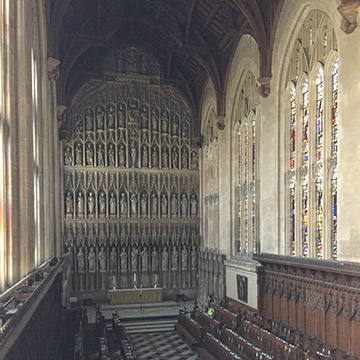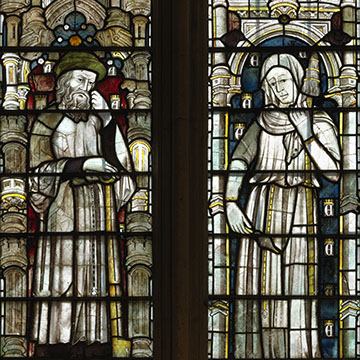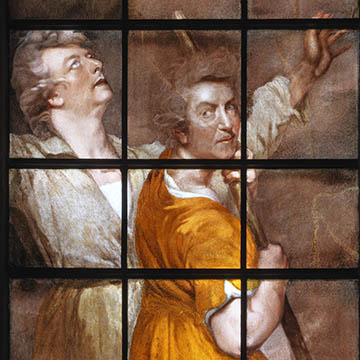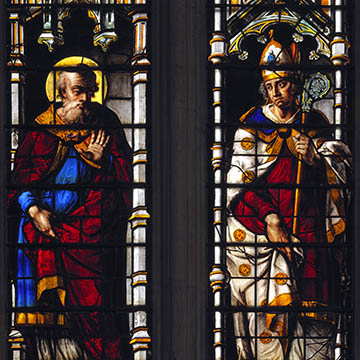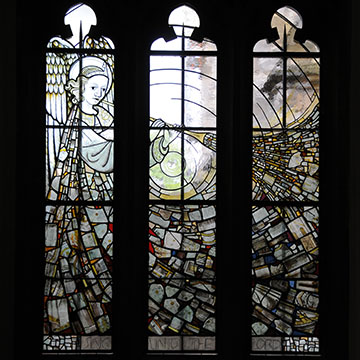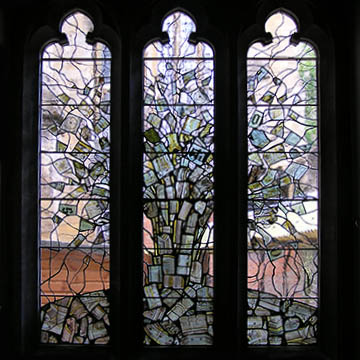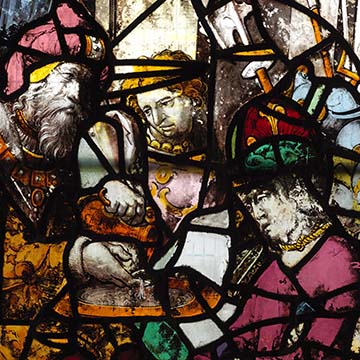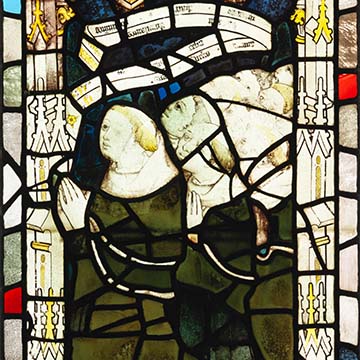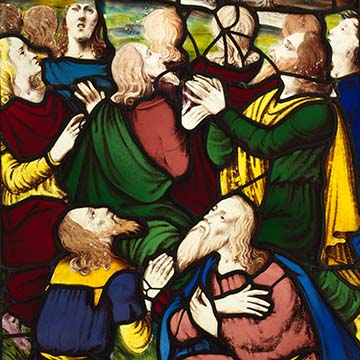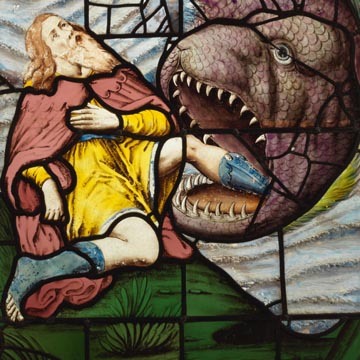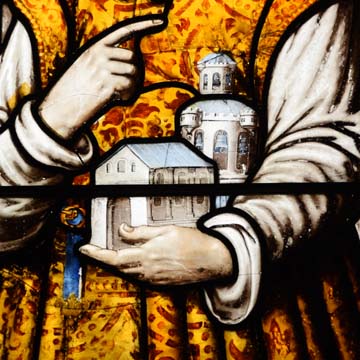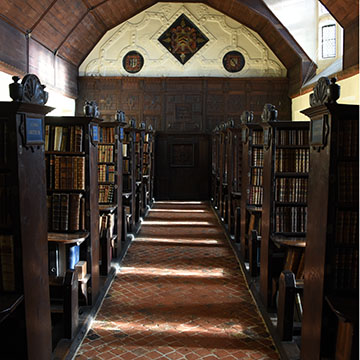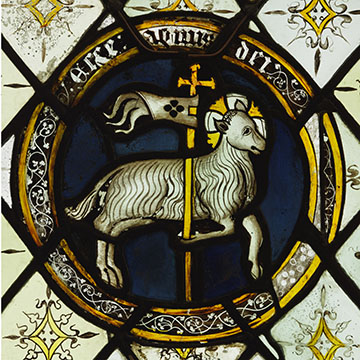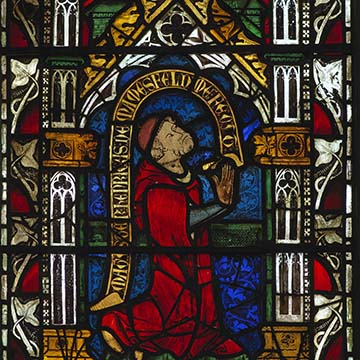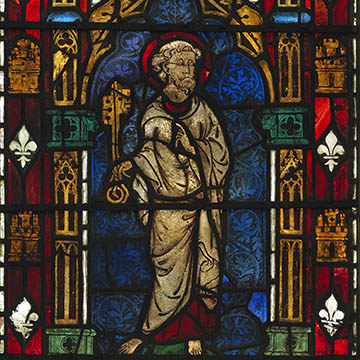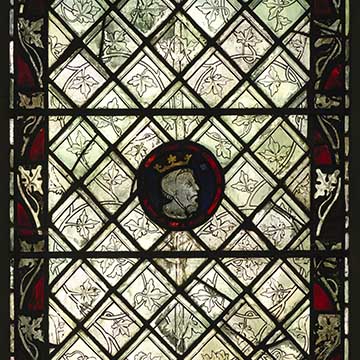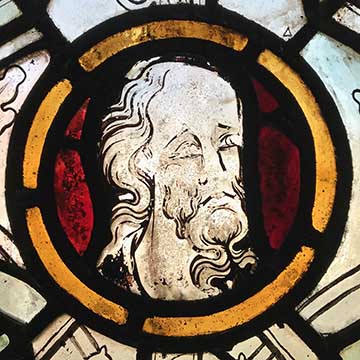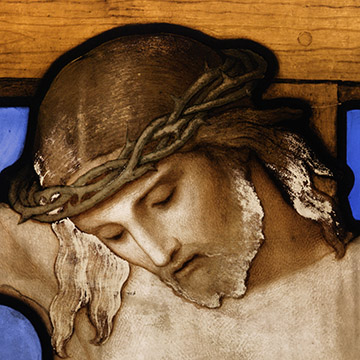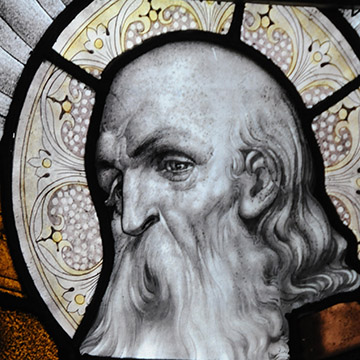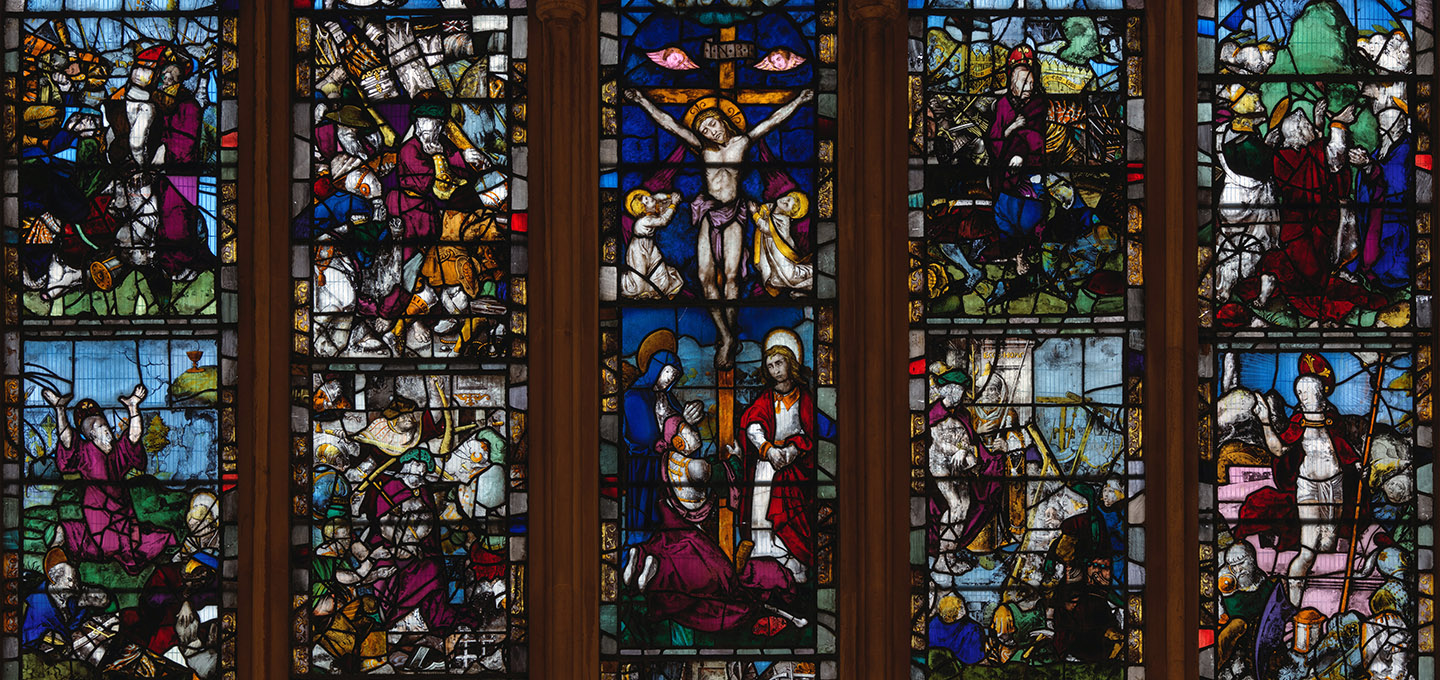
Stained Glass in Oxford, UK
Over 50 Years of Excellence in Stained Glass Craft and Conservation
The York Glaziers Trust has undertaken conservation and consultation work for over a quarter of Oxford's 38 world-renowned Grade I listed colleges including All Souls, Balliol, Lincoln, Magdalen, Merton, New, Queen's, Trinity, and Wadham colleges, as well as the Bodleian Library. The Trust's special relationship with the University of Oxford is longstanding, having been associated with the care of its stained glass for well over four decades.
New College
The medieval glazing of New College's chapel was commissioned by William Wykeham, Lord Chancellor of England, Bishop of Winchester, and founder of New College. The work was undertaken by Oxford-based craftsman Thomas Glazier (fl. 1386-1427), a leading proponent of the International Gothic style, and one of the earliest identifiable stained glass artists. Much of the surviving medieval glazing is found in the ante-chapel. The chapel's north windows, depicting apostles and saints, were re-glazed in the eighteenth-century by William Peckitt (1731-1795) of York, a leading stained glass artist. Other windows in the chapel are by William Price the Younger. The west window, depicting the Seven Virtues and begun in 1779, was a collaboration between Sir Joshua Reynolds (1723-1792) and Dublin-born glass-painter Thomas Jervais (d.1799).
The York Glaziers Trust has been associated with New College for over thirty years. Over this time, many of the chapel's nationally significant windows have been carefully conserved, and returned to the chapel as part of a custom-designed internally ventilated protection system, ensuring the windows can be enjoyed for generations to come. The Trust first began working with the college in the 1980s, beginning with priority windows in the antechapel. As well as in the chapel, the Trust has also undertaken work for the college in many of their other buildings, such as the Old Bursary, Vestry, Song Room, Great Hall, and Warden's Lodge. The Trust's work with the college includes not only conservation of their historic windows, but also several award-winning new designs, incorporating some of the college's collections of medieval glass fragments as part of exciting new artworks.
Balliol College
The Trust has worked extensively at Balliol College over a period of two decades, in both the chapel and old library. Most recently the Trust has turned their attention to the conservation of the chapel's sixteenth-century east window. Depicting scenes from the Passion, Resurrection and Ascension after Dürer, is thought to have been by the Flemish glazier James Nicholson, a glass-artist favoured by Cardinal Thomas Wolsey. Other windows in the chapel, dating to 1637, have been attributed to Abraham Van Linge (fl. 1625-1641), member of a family of celebrated continental glass-painters whose work was much prized in Oxford during this period. There are also important nineteenth-century panels by Michael O'Connor and Sons.
Lincoln College
The stained glass in the chapel is the work of continental glazier Abraham van Linge (fl.1629-1641), and includes typologically arranged scenes from the life of Christ, as well as the Apostles, with the accompanying Apostle's Creed inscribed beneath. Remarkably the chapel retains its original glazing scheme, and in particular the East window is a masterpiece of design and artistry, and dates to 1631. The chapel windows are acknowledged as important examples of seventeenth-century church art.
The Trust has also surveyed and conserved a series of exceptional sixteenth and seventeenth-century Netherlandish roundels in the Oakshott room. These had originally been assembled by Sir Walter Fraser Oakshott (1903-87), former rector of Lincoln College and vice-chancellor of the University of Oxford. Scenes depicting the Prodigal Son, Jonah and the Whale and Susanna and the Elders prevail. Following refurbishment of the building that housed the panels, the stained glass was returned with the benefit of a custom-designed internally ventilated protective glazing, in order to arrest any environmental deterioration.
Most recently, YGT has been working to conserve a series of four high-quality nineteenth-century lancets. These panels have not been on display for nearly three decades; having been in storage since the early 1990s. This stained glass was originally made for the oriel window of a fellow's room, adjacent to the chapel, and depicts the original founders of the College. This includes the only known figural depictions in stained glass of the two central founders Richard Fleming (c.1385-1431), Bishop of Lincoln Cathedral (1420-1431), and Thomas Rotherham (1423-1500), who was Bishop of Lincoln Cathedral (1472-1480) and Archbishop of York (1480-1500).
Wadham College
The York Glaziers Trust was commissioned to survey and provide a suitable conservation approach for the east window of Wadham College's chapel. A programme of in situ cleaning and repairs followed, including weatherproofing with glazing putty, renewal of broken solder joints in the lead, edge-bonding loose glass and renewal of any loose supporting ties. The east window, executed in 1622, is of exceptional rarity and skill, and is the work of Bernard van Linge (1598-1644), brother of Abraham van Linge who was responsible for the glazing at Lincoln College and Balliol College chapels. The window depicts Christ's Passion, and has been typologically arranged. Together with Lincoln's east window, these two examples provide the two most perfected expressions of seventeenth-century English Arminian principles in the stained glass medium. After a severe storm had damaged sections of the window in 2015, the Trust carried out an emergency removal of all damaged sections, before edge-bonding, cleaning, and returning the panels to the chapel.
Merton College
Since 2013, the York Glaziers Trust has been involved with the surveying and monitoring of the 39 windows in the Old Library at Merton College. Established in 1373, Merton library is the oldest continuously functioning library in the world. In the library, the Trust has fully conserved and framed a trial window, and returned this to the library with state-of-the-art protective glazing capable of filtering ultra-violet light. This material not only protects the photo-sensitive conservation materials, but also the valuable and priceless ancient books housed in the library. The library contains medieval glass pieces gathered from elsewhere in the college, as well as mid nineteenth-century windows by the London stained glass firm James Powell and Sons.
YGT has also surveyed the college's chapel, which contains some of the best preserved examples of their type in Europe. The exceptionally rare and important fourteen monumental north and south windows are part of a single, unified early fourteenth-century band window scheme depicting Apostles, Evangelists, and kneeling donor figures in academic dress. The windows in the north transept, dating to 1702, were formerly located in the chapel's east window, and are by William Price Senior (d.1722), a member of a respected glass-painting dynasty.
Trinity College
Trinity College Chapel contains a scheme of nineteenth-century stained glass, executed in 1885-86 by London stained glass firm James Powell and Sons. The panels were designed and cartooned by the studios principal in-house designer J. W. Brown (1842-1928). These fine windows depict saints relevant to the history of the college, founded in the late fourteenth-century by the Benedictines of Durham Cathedral. The Trust was commissioned to contribute to a conservation strategy for the whole chapel, one of the finest Baroque interiors in England. After a survey of the chapel's glass, an extensive preventative programme of in situ cleaning was employed in order to remove layers of hygroscopic dirt. As part of YGT's work, panels stored in an attic space were also assessed. Depicting the Crucifixion of Christ flanked by the Blessed Virgin and St John the Evangelist, the stored window is the work of the Königliche Glasmalereianstalt (The Royal Bavarian Stained Glass Establishment) in Munich, the most influential workshop for stained glass in central Europe during the nineteenth-century. While seven of the chapel's windows contained Powell and Sons stained glass, an eighth window opening contained only plain leaded lights. This window had previously been filled with the panels from the window now in storage, dating to the 1860’s and honouring Trinity Fellow Isaac Williams (d. 1865). This window had been removed in 1947, but was never reinstated. As part of the major restoration project, the College decided that the Isaac Williams window should be reinstalled into its original opening, and so the glass was brought back to York where it was meticulously conserved during the summer of 2015. YGT has also provided conservation recommendations for the stained glass in the old library and dining hall.
Awards:
2007 Oxford Preservation Trust, Chapel Restoration, New College
2016 Oxford Preservation Trust, Chapel Restoration, Trinity College
Selected Bibliography:
H. Arnold, The Glass in Balliol College Chapel, Oxford, 1914
T. Ayers, The Medieval Stained Glass of Merton College, Oxford, Corpus Vitrearum Medii Aevi (CVMA) Great Britain, VI, 2 vols., Oxford, 2013
T. Brighton and B. Sprakes, 'Medieval and Georgian Stained Glass in Oxford and Yorkshire: The Work of Thomas of Oxford (1385-1427) and William Peckitt of York (1731-95) in 'New College Chapel, York Minster and St James' High Melton', Antiquaries Journal, 70 (2), 1990, pp. 380-441
J. Buxton and P. Williams, New College, Oxford, 1379-1979, Oxford, 1979
J. Jago, 'The dissemination and reassessment of private religious space in early modern England: an examination of the cultural contexts surrounding royal, episcopal and collegiate chapels from the accession of James I to the restoration', PhD Thesis, University of York, 2012
R. Marks, Stained Glass in England in the Middle Ages, Routledge, 1993
P. Newton, 'Schools of Glass Painting in the Midlands, 1275-1430', PhD Thesis, University of London, 1962
P. Newton, The County of Oxford: A Catalogue of Medieval Stained Glass, Corpus Vitrearum Medii Aevi (CVMA) Great Britain, London, 1979
H. J. Powell, 'The Picture Windows in New College Ante-Chapel', Burlington Magazine, 1906, vol. 8, no. 35, pp. 316-26
C. Winston, 'The Painted Glass in New College Chapel and Hall, Oxford', Memoirs Illustrative of the Art of Glass-Painting, 1865, pp. 130-59
C. Woodforde, The Stained Glass of New College, Oxford, Oxford, 1951
Get In Touch
If you would like more information on our conservation services please get in touch.
Contact UsContact Us
The York Glaziers Trust, 6 Deangate, York, YO1 7JB

